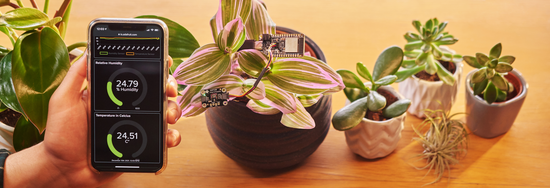Adafruit IoT Monthly: Helping Harry's Heart, CircuitPython meets AWS IoT and more!
IoT Projects
Helping Harry’s Heart

Adam Taylor built a remote monitoring system to monitor his dog’s respiration rate to help the vet to adjust his heart medication. They used a X4M200 respiration sensor fitted to Harry’s (the dog) harness. Adam used Adafruit IO to send the dog’s heart rate to the internet, privately. “Along with [the] graphical view, I can also see the time stamped data” to share with “the cardiac specialist at Harry’s next appointment. - Hackster.io
CircuitPython BLE Remote Control On/Off Switch

rdagger has “multiple computers around the house, and sometimes they need to be rebooted remotely.”. Instead of manually opening the locked closet and rebooting their NAS, rdagger opted for a different approach. They built a BLE peripheral which “attaches to the front so the server can be turned on remotely from outside the closet”. - Read the guide on the Adafruit Learning System
Hacking the Sonos Ikea Symfonisk into a High-Quality Amplifier

Ikea released a $99 SONOS-compatible speaker, but a plastic enclosure can’t hold a candle to a pair of high-quality wooden speakers. Ben Hobby grabbed some tools and (literally) hacked one apart to connect it to his bookshelf speakers so you don’t have to. - Makezine.
PyPortal IoT Plant Monitor with AWS IoT and CircuitPython

This smart-planter monitors your plant’s vitals on the PyPortal’s screen, logs data to Amazon AWS IoT, and sends an email to your inbox when your plant needs to be watered! Using Amazon AWS IoT with CircuitPython allows you to prototype internet-of-things projects faster than ever before. With CircuitPython, you’re able to instantly provision your device for AWS IoT by dragging and dropping certificates/keys. - Adafruit Learning System
Mini Smart Home with Huzzah, HASSio and Crickit

The Mini Smart Home is a test bed that can let you move one step closer to making a truly smart Smart Home. When finished, you will have a completely independent system that hosts a customizable browser based User Interface, a device management system, usage and data logging, advanced automation tools, and user account security. This is all done with a Smart Home server OS called Home Assistant. - Adafruit Learning System
Around the Internet – IoT News and Links
Tearing Down Quirky’s Egg-Minder

A teardown of the (now defunct) Quirky’s Egg-Minder reveals a well-designed IoT product before the ESP8266 was “a thing” - HackADay
Debugging the ESP32 ESP-IDF with a Segger JLink

Using the ESP32 as a WiFi Coprocessor (like Adafruit AirLift boards running the excellent nina-fw firmware) is becoming more popular. Instead of printf()’ing your way through ESP-IDF and mbed - this post details a method of using the Eclipse IDE and a JLink debugger. - DZone
Amazon’s Quest to put Alexa everywhere

Aside from the usual smart-speaker, Amazon released a bevy of new hardware supporting their Alexa voice assistant earlier this month. This hardware ranges from a wearable wing to Alexa-compatible eyeglasses. But what’s the goal of releasing all this hardware so quickly? - VentureBeat
Why Engineering Teams Are Shutting Down Industrial IoT Projects

Despite the previous accomplishments of their profession, engineering teams are unexpectedly shutting down industrial IoT projects at an alarming rate. But why now? It seems like IoT, as an industry, is evolving daily with new hardware advances. - DZone
MCCI Catena 4618 is a Cortex M0+ LoRaWan + sensors in a Feather footprint

MCCI has released the Catena 4618, a complete single-board IoT device and sensors for LoRaWAN projects.
Based on the Murata CMWX1ZZABZ-078, and designed to be compatible with the MCCI Catena 44xx and 46xx family and the Adafruit Feather family of development boards and accessories, the Catena 4618 is a great platform for LoRaWAN investigation and deployment. It works well with The Things Network, or any LoRaWAN 1.0 or 1.1 network in the 865 to 923 MHz range.
The board is available from the MCCI online store and more information is available on the MCCI website.
NoCAN - a new type of wireless sensor network

Transmitting data over SPI/I2C wires does not work well for long distances, you can transmit longer distances but only when reducing the frequency. The NoCAN platform allows creation of a reliable sensor network with nodes connected through a CAN bus. It includes a dynamic-address-assignment scheme from a node manager when it’s bootstrapped (just like DHCP). - Omzlo
ESP32 and Raspberry Pi Zero W in Space

The APEX experiment brought two ESP32s and a Raspberry Pi Zero into space to evaluate faster embedded computing options for space-flight.
The main board included two ESP32s and a Raspberry Pi Zero W, running resinOS / balenaOS, an operating system designed to run parallel Docker containers and optimized for IoT fleet management.
MQTT Security 101

The internet-of-thing’s favorite low-power protocol, MQTT, doesn’t require any security measures. But it’s 2019 and we should enforce best practices, this article dives into the vulnerabilities, and security measures to take from a broker or client perspective. - Medium
The ESP32MX-E is a robust ESP32 platform

Between an active community, a low price-point, and ongoing development, the ESP32 is an attractive choice for connecting internet-of-things projects to the internet. The the esp32MX-E takes the ESP32 one-step further by adding a STMicroelectronics STM32F030F4 and Ethernet support. This project is coming soon, sign up on the project Crowd Supply page to receive updates.
Scientists tracking eagle’s migration patterns rack up roaming charges

Russian scientists tracking the migration patterns of eagles suddenly ran out of money when they found the eagles were migrating hundreds of miles away to Pakistan and Iran, racking up thousands of dollars of roaming charges. While this is funny, it’s also a scenario one should consider when building mobile IoT projects. - BBC News
Track Ocean Currents with the Maker Buoy Kit

The Maker Buoy Project’s Arduino-based drifting buoy is the “Internet of Things applied to the ocean”. If you’re an oceanographer or marine biologist looking for a robust, open-source, buoy system - look no further than the Maker Buoy’s prebuilt kits. Maker Buoy now offers pre-populated PCBs, complete kits and bare-PCB hardware on their store.
Adafruit IOT Updates
New Adafruit IO Block - Multi-line text block

If you have an Adafruit IO Feed containing a lot of text (tweets, packed data from one sensor, etc.), you can now format and display your feeds on your Adafruit IO dashboard using a multi-line text block. – Visit your Adafruit IO Dashboard to try it out now
SmartiPi Touch 2 - Stand for Raspberry Pi 7” Touchscreen Display

If you’re running a smart-home setup and want to build an inexpensive central monitoring display, the SmartiPi Touch 2 is a well-designed stand for the Raspberry Pi 7” touchscreen display. Run Chromium in kiosk mode with the page set to Home Assistant or your Adafruit IO dashboard and you’ll have a touch-enabled smart-thing display - visit the Product Page here.
Coming Soon - Adafruit Feather STM32F405 Express

The new STM32F405 Feather (video) that Adafruit designed runs CircuitPython at a blistering 168MHz – our fastest CircuitPython board ever! We’ve tried it out with an AirLift Breakout and it’s incredibly quick. This may be the CircuitPython Feather you want powering your IoT project. The Feather SM32F405 Express is not yet available - sign up to be notified when it is put in stock.
What is Adafruit.IO?
Adafruit.io has over 14,000+ active users in the last 30 days and 850+ Adafruit IO Plus subscribers. Sign up for Adafruit IO (for free!) by clicking this link. Ready to upgrade? Click here to read more about Adafruit IO+, our subscription-based service. We don’t have investors and we’re not going to sell your data. When you sign up for Adafruit IO+, you’re supporting the same Adafruit Industries whose hardware and software you already know and love. You help make sure we’re not going anywhere by letting us know we’re on the right track.
Support Adafruit

Here at Adafruit, we sell all of these amazing components, but we couldn’t find a good way to interact with them over the Internet. So, we decided to create our own IoT platform, and that’s Adafruit IO. It’s built from the ground up to be easy to use and platform agnostic (connect any development board or device!). For those who want to get a project off the ground without programming - Adafruit IO offers a No-Code interface for building IoT electronics projects using WipperSnapper, our open-source IoT firmware. Support Adafruit’s open-source development by subscribing to Adafruit IO Plus, the upgraded, all-systems-go version of the Adafruit IO service.
